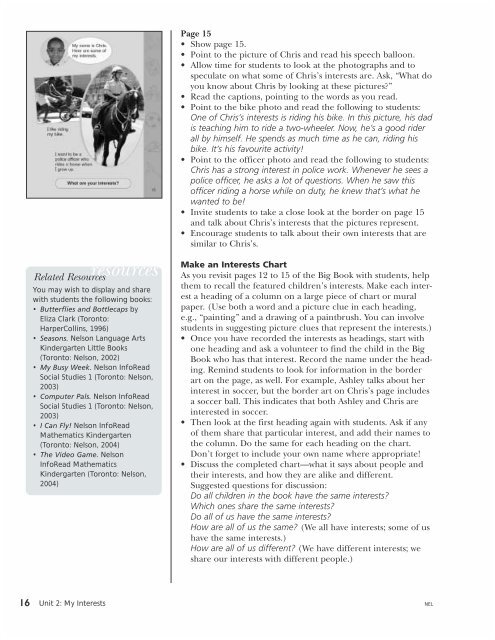Download the K TR Sampler - Nelson Education
Download the K TR Sampler - Nelson Education
Download the K TR Sampler - Nelson Education
Create successful ePaper yourself
Turn your PDF publications into a flip-book with our unique Google optimized e-Paper software.
esources<br />
Related Resources<br />
You may wish to display and share<br />
with students <strong>the</strong> following books:<br />
• Butterflies and Bottlecaps by<br />
Eliza Clark (Toronto:<br />
HarperCollins, 1996)<br />
• Seasons. <strong>Nelson</strong> Language Arts<br />
Kindergarten Little Books<br />
(Toronto: <strong>Nelson</strong>, 2002)<br />
• My Busy Week. <strong>Nelson</strong> InfoRead<br />
Social Studies 1 (Toronto: <strong>Nelson</strong>,<br />
2003)<br />
• Computer Pals. <strong>Nelson</strong> InfoRead<br />
Social Studies 1 (Toronto: <strong>Nelson</strong>,<br />
2003)<br />
• I Can Fly! <strong>Nelson</strong> InfoRead<br />
Ma<strong>the</strong>matics Kindergarten<br />
(Toronto: <strong>Nelson</strong>, 2004)<br />
• The Video Game. <strong>Nelson</strong><br />
InfoRead Ma<strong>the</strong>matics<br />
Kindergarten (Toronto: <strong>Nelson</strong>,<br />
2004)<br />
Page 15<br />
• Show page 15.<br />
• Point to <strong>the</strong> picture of Chris and read his speech balloon.<br />
• Allow time for students to look at <strong>the</strong> photographs and to<br />
speculate on what some of Chris’s interests are. Ask, “What do<br />
you know about Chris by looking at <strong>the</strong>se pictures?”<br />
• Read <strong>the</strong> captions, pointing to <strong>the</strong> words as you read.<br />
• Point to <strong>the</strong> bike photo and read <strong>the</strong> following to students:<br />
One of Chris’s interests is riding his bike. In this picture, his dad<br />
is teaching him to ride a two-wheeler. Now, he’s a good rider<br />
all by himself. He spends as much time as he can, riding his<br />
bike. It’s his favourite activity!<br />
• Point to <strong>the</strong> officer photo and read <strong>the</strong> following to students:<br />
Chris has a strong interest in police work. Whenever he sees a<br />
police officer, he asks a lot of questions. When he saw this<br />
officer riding a horse while on duty, he knew that’s what he<br />
wanted to be!<br />
• Invite students to take a close look at <strong>the</strong> border on page 15<br />
and talk about Chris’s interests that <strong>the</strong> pictures represent.<br />
• Encourage students to talk about <strong>the</strong>ir own interests that are<br />
similar to Chris’s.<br />
Make an Interests Chart<br />
As you revisit pages 12 to 15 of <strong>the</strong> Big Book with students, help<br />
<strong>the</strong>m to recall <strong>the</strong> featured children’s interests. Make each interest<br />
a heading of a column on a large piece of chart or mural<br />
paper. (Use both a word and a picture clue in each heading,<br />
e.g., “painting” and a drawing of a paintbrush. You can involve<br />
students in suggesting picture clues that represent <strong>the</strong> interests.)<br />
• Once you have recorded <strong>the</strong> interests as headings, start with<br />
one heading and ask a volunteer to find <strong>the</strong> child in <strong>the</strong> Big<br />
Book who has that interest. Record <strong>the</strong> name under <strong>the</strong> heading.<br />
Remind students to look for information in <strong>the</strong> border<br />
art on <strong>the</strong> page, as well. For example, Ashley talks about her<br />
interest in soccer, but <strong>the</strong> border art on Chris’s page includes<br />
a soccer ball. This indicates that both Ashley and Chris are<br />
interested in soccer.<br />
• Then look at <strong>the</strong> first heading again with students. Ask if any<br />
of <strong>the</strong>m share that particular interest, and add <strong>the</strong>ir names to<br />
<strong>the</strong> column. Do <strong>the</strong> same for each heading on <strong>the</strong> chart.<br />
Don’t forget to include your own name where appropriate!<br />
• Discuss <strong>the</strong> completed chart—what it says about people and<br />
<strong>the</strong>ir interests, and how <strong>the</strong>y are alike and different.<br />
Suggested questions for discussion:<br />
Do all children in <strong>the</strong> book have <strong>the</strong> same interests?<br />
Which ones share <strong>the</strong> same interests?<br />
Do all of us have <strong>the</strong> same interests?<br />
How are all of us <strong>the</strong> same? (We all have interests; some of us<br />
have <strong>the</strong> same interests.)<br />
How are all of us different? (We have different interests; we<br />
share our interests with different people.)<br />
16<br />
4 Unit 2: My Interests NEL

















